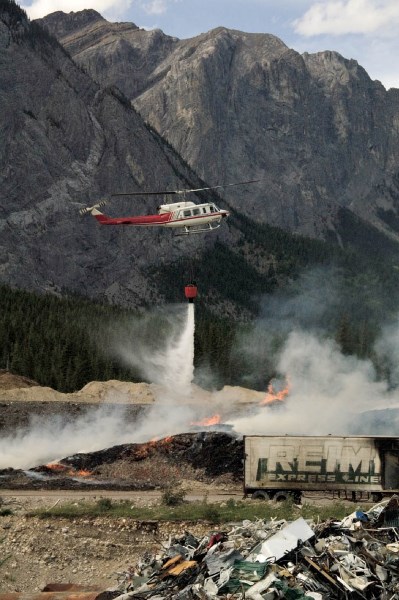Minutes before 11 p.m. Saturday night (July 16), MD of Bighorn Reeve Dene Cooper sped down Highway 1A with his wife Jean to the Francis Cooke Landfill site five minutes east of Exshaw.
Flames bathed the surrounding cliffs in orange light, throwing embers 600-metres into the surrounding forest. A massive pile of dry, sorted wood, which the landfill had collected for the past eight months to chip and resell, was now a towering inferno, spreading the width of a football field.
Before the Reeve sat the biggest fire in MD of Bighorn history.
“I came around the corner and saw a wall of flame shooting sparks higher than I thought possible. I knew we would be in trouble if it got in the trees,” Cooper said.
For the next hour, firefighters struggled to remove the grim spectre of a massive forest fire, with visions of Slave Lake no doubt haunting them. Sheet lightning flashed ominously overhead and the infamous Exshaw winds whipped up flames under the midnight moon.
At 12:30 a.m., the flames headed north towards the forest.
The fire, which was reported Saturday at 10:45 p.m. by a passing motorist, had grown into a potential threat not only to those in the immediate vicinity but to the 4,000 neighbours in Morley to the east, as well.
But the firefighters were prepared for the test.
About 60 MD of Bighorn and Sustainable Resource Development firefighters fought the fire through the night, first to contain it to the landfill, then to remove the heat. Without water nearby, crews relied on tanker trucks filling up at new fire hydrants in Exshaw, dumping over 2,000 cubic metres of municipal water over Sunday and Monday.
“The water supply was an issue. It’s a huge fuel load and takes a massive amount of water to put it out,” said MD of Bighorn Fire Chief Rick Lyster.
Armed with years of forest fire fighting expertise, SRD arrived with the tools to fight a blaze of this magnitude. By 4 a.m., the MD firefighters left, while SRD worked through the night, not only on the fire, but also in the nearby forest.
“We saw embers landing in trees and staying lit for some time,” Lyster said.
By morning, a water bomber and four helicopters were working tirelessly to dump water on the fire, cutting the flames down to a manageable size. Fire retardant dumped on the adjacent trees and fences painted them red in the process. The height of the flames had been knocked down and the nature of the fire and situation changed. SRD handed over control of the fire to the MD of Bighorn.
By 12:12 p.m., the MD had declared a state of emergency, allowing them to access more resources. Four municipal tanker trucks and four contracted water trucks from local businesses helped quell the water issue, as they filled portable containers the size of outdoor swimming pools.
Even boy scouts know the key to extinguishing a fire is removing heat. Using that simple principle, firefighters spent two days dousing the woodpile with water and then spreading the ashes with a massive track-hoe bucket while adding more water.
“We’re tearing her apart and cooling her down,” Lyster said.
The system worked perfectly, said the MD of Bighorn’s director of disaster services Hugh Pettigrew, and while the state of emergency was still in place, he was optimistic about the outcome.
Cooper had nothing but praise for local and neighbouring firefighters.
“This stretched our resources. I’m very grateful for the assistance from SRD. They formed an attack plan and implemented it expertly,” Cooper said.
“If not for quick action, it could have been a very different outcome,” said Pettigrew.
“Never has our fire system been so tested,” he said. “But the pros are doing their job.”
Sunday, Cooper, Pettigrew and Lyster surveyed the fire sight. Two choppers were still circling overhead, pulling water from the Bow River and the initial fears of wildfire were tempered by the expertise displayed by the fire crews. At that time, they still expected the fire to burn for another 72 hours.
The fire is deep in there. If we were next to a lake, it would be a different matter,” Lyster said.
Although the cause of the fire is unknown, Pettigrew said it began on the Francis Cooke Landfill’s recycled woodpile and quickly spread to the adjacent pile of shredded wood.
According to the Francis Cooke Landfill chief administrative officer Darcy Edison, the fire consumed 16,000 cubic metres of recycled wood, 4,000 cubic metres of which had already been chipped.
SRD has launched an investigation into the cause of the fire as the MD is within the Alberta Forest Protection area.
Cooper noted lightning was spotted Saturday night, and the landfill site has had problems with trespassing in the past.
Once public safety and property concerns were satisfied, thoughts turned to other concerns.
“We lost eight months of material,” Cooper said, who also sits on the Bow Valley Waste Commission. “It represented a recyclable material customers were willing to purchase.”
Cooper did mention two strokes of luck. The massive and expensive chipper that usually sits next to the woodpile had been moved into the machine shop that week for repairs. A trommel screener, which sizes the wood and usually sits next to the chipper, was on loan to Banff.
And while luck played a part, it was not the cause of an averted disaster.
“Skills and organization have turned this story around,” Cooper said.
The MD lifted the state of emergency on Tuesday and the landfill re-opened Wednesday.




